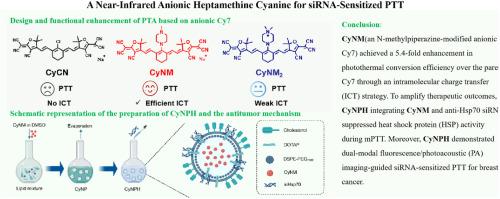用于sirna敏化光热治疗的近红外阴离子七甲基氰菁
IF 4.2
3区 工程技术
Q2 CHEMISTRY, APPLIED
引用次数: 0
摘要
光热疗法(Photothermal therapy, PTT)虽然对肿瘤细胞消融有效,但由于温度过高导致的热损伤,阻碍了其临床应用。轻度光热疗法(mPTT)是一种副作用较小的有希望的替代疗法。光热剂作为mPTT的关键组成部分,其性能优化具有重要意义。在这项研究中,我们开发了一种n -甲基哌嗪修饰的阴离子Cy7 (CyNM),通过分子内电荷转移(ICT)策略,其光热转换效率比母体Cy7提高了5.4倍。为了扩大治疗效果,我们通过整合CyNM和抗hsp70 siRNA来设计CyNPH,以抑制mPTT期间热休克蛋白(HSP)的活性。此外,CyNPH显示了双模态荧光/光声(PA)成像引导sirna致敏的乳腺癌PTT。值得注意的是,这项工作为阴离子pta和图像引导mPTT的合理设计提供了新的见解,并展示了巨大的临床转化潜力,从而提供了一种简单可控的治疗策略。本文章由计算机程序翻译,如有差异,请以英文原文为准。

A near-infrared anionic heptamethine cyanine for siRNA-sensitized photothermal therapy
Photothermal therapy (PTT), though effective for tumor cell ablation, is hindered in clinical applicability due to hyperthermia injury caused by excessive temperatures. Mild photothermal therapy (mPTT) presents a promising alternative with reduced side effects. As pivotal components of mPTT, the performance optimization of photothermal agents (PTAs) hold critical importance. In this study, we developed an N-methylpiperazine-modified anionic Cy7 (CyNM) that achieved a 5.4-fold enhancement in photothermal conversion efficiency over the parent Cy7 through an intramolecular charge transfer (ICT) strategy. To amplify therapeutic outcomes, we engineered CyNPH by integrating CyNM and anti-Hsp70 siRNA to suppress heat shock protein (HSP) activity during mPTT. Moreover, CyNPH demonstrated dual-modal fluorescence/photoacoustic (PA) imaging-guided siRNA-sensitized PTT for breast cancer. Notably, this work offers novel insights into the rational design of anionic PTAs and image-guided mPTT, and demonstrates substantial clinical translation potential, thereby providing a simple and controllable treatment strategy.
求助全文
通过发布文献求助,成功后即可免费获取论文全文。
去求助
来源期刊

Dyes and Pigments
工程技术-材料科学:纺织
CiteScore
8.20
自引率
13.30%
发文量
933
审稿时长
33 days
期刊介绍:
Dyes and Pigments covers the scientific and technical aspects of the chemistry and physics of dyes, pigments and their intermediates. Emphasis is placed on the properties of the colouring matters themselves rather than on their applications or the system in which they may be applied.
Thus the journal accepts research and review papers on the synthesis of dyes, pigments and intermediates, their physical or chemical properties, e.g. spectroscopic, surface, solution or solid state characteristics, the physical aspects of their preparation, e.g. precipitation, nucleation and growth, crystal formation, liquid crystalline characteristics, their photochemical, ecological or biological properties and the relationship between colour and chemical constitution. However, papers are considered which deal with the more fundamental aspects of colourant application and of the interactions of colourants with substrates or media.
The journal will interest a wide variety of workers in a range of disciplines whose work involves dyes, pigments and their intermediates, and provides a platform for investigators with common interests but diverse fields of activity such as cosmetics, reprographics, dye and pigment synthesis, medical research, polymers, etc.
 求助内容:
求助内容: 应助结果提醒方式:
应助结果提醒方式:


